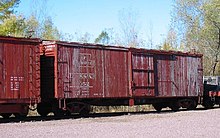Boxcar
This article needs additional citations for verification. (February 2016) |



A boxcar is the North American (AAR) term for a railroad car that is enclosed and generally used to carry freight. The boxcar, while not the simplest freight car design, is considered one of the most versatile since it can carry most loads. Boxcars have side sliding doors of varying size and operation, and some include end doors and adjustable bulkheads to load very large items.
Similar covered freight cars outside North America are covered goods wagons and, depending on the region, are called goods van (UK and Australia), covered wagon (UIC and UK) or simply van (UIC, UK and Australia).[a]
Use

Boxcars can carry most kinds of freight. Originally they were hand-loaded, but in more recent years mechanical assistance such as forklifts have been used to load and empty them faster. Their generalized design is still slower to load and unload than specialized designs of car, and this partially explains the decline in boxcar numbers since World War II. The other cause for this decline is the dramatic shift of waterborne cargo transport to container shipping. Effectively a boxcar without the wheels and chassis, a container is designed to be amenable to intermodal freight transport, whether by container ships, trucks or flatcars, and can be delivered door-to-door.
Later grain transport would use metal reinforced cardboard which was nailed over the door and could be punctured by a grain auger for unloading. It was also impossible to mechanically load and unload. Grain can also be transported in boxcars designed specifically for that purpose; specialized equipment and procedures are required to load and unload the cars. However, the grain is better transported in covered hopper cars. Originally made of all wood construction, with beam frame, and frame sides and roofs, the cars were a fire hazard. The beam frame was limited to a 25-foot (7.62 m) length. In the 1930s, pressed steel ends were added as were steel under framing. In the late 1960s the Federal Railway Administration outlawed wood cars and they were slowly removed from the fleet. With steel frames, longer box cars were possible and thus forty-and-fifty-foot (12.192 and 15.240 m) cars emerged. Heavy loads of cement or beer can make a boxcar load in the 50-or-60-short-ton (44.6-or-53.6-long-ton; 45.4 or 54.4 t) range.
Boxcars were used for bulk commodities such as coal, particularly in the Midwestern United States in the early 20th century. This use was sufficiently widespread that several companies developed competing box-car loaders to automate coal loading. By 1905, 350 to 400 such machines were in use, mostly at Midwestern coal mines.[2]
Hicube boxcar
In the 21st century, high cubic capacity (hicube) boxcars have become more common in the US. These are taller than regular boxcars and as such can only run on routes with increased clearance (see loading gauge and structure gauge). The excess height section of the car end is often painted with a white band to be easily visible if wrongly assigned to a low-clearance line.[3]
The internal height of the 86-foot (26.21 m) hicube boxcars originally used in automotive parts service was generally 12 feet 9 inches (3.89 m).[4]
Passenger use
In the Philippines, Boxcars were used as additional third-class accommodations by the Manila Railway Company during the early 1900s as there was a shortage of true passenger railroad cars.[5] These problems were considered solved by the 1910s as British manufacturer Metropolitan and American builders such as Harlan and Hollingsworth constructed more passenger cars for the railroad.[6]
In the present day, hobos and migrant workers have often used boxcars in their journeys (see freighthopping), since they are enclosed and cannot be seen by railroad police, as well as being to some degree insulated from cold weather.[7] Hobo Code, a form of hieroglyphs used by hobos, developed as a code to give information to Hobos frieghthopping.[8]
See also
- Autorack – A modern, enclosed railroad car designed to carry automobiles
- General Utility Van – Enclosed railway wagon used by British Rail to carry mail and parcels
- Railbox – American owner of boxcars
- Stock car
- Troop sleeper
Notes
- ^ An exception in Australia was the former South Australian Railways, which adopted US practices and terminologies; it used the term "boxcar".[1]: 1‑129
References
- ^ McAuliffe, Des (1999). "The Snowtown to Port Pirie line". Proceedings of the 1999 Convention. Modelling the Railways of South Australia. Adelaide.
- ^ Affelder, William L. (March 1905). "Box-Car Loaders". Mines and Minerals. XXV (8): 372–377. Retrieved May 11, 2018.
- ^ "60 ft Hicube boxcar" (PDF). GBRX.com. Archived from the original (PDF) on November 14, 2012. Retrieved June 6, 2011.
- ^ Chatfield, D. Scott (January 1994). "Athearn HO Scale and Arnold N Scale 86-foot Box Cars". Railmodel Journal. 5 (8). Denver, Colorado: Golden Bell Press: 32–39.
- ^ "Rolling stock of the Manila Railroad Co. 1904". Railroad Gazette. 35 (48). 1903.
- ^ Report of the General Manager for the Year Ended December 31, 1938. Reports of the General Manager (Report). Manila Railroad Company. March 17, 1939.
- ^ "Train Hopping: Why Do Hobos Risk Their Lives to Ride the Rails?". BBC News. December 19, 2012. Retrieved June 25, 2022.
- ^ Berendsohn, Roy (November 17, 2020). "Those Hobo Hieroglyphs That Appeared on Posts and Bridge Abutments Relayed Important Messages". Popular Mechanics. Retrieved June 25, 2022.
